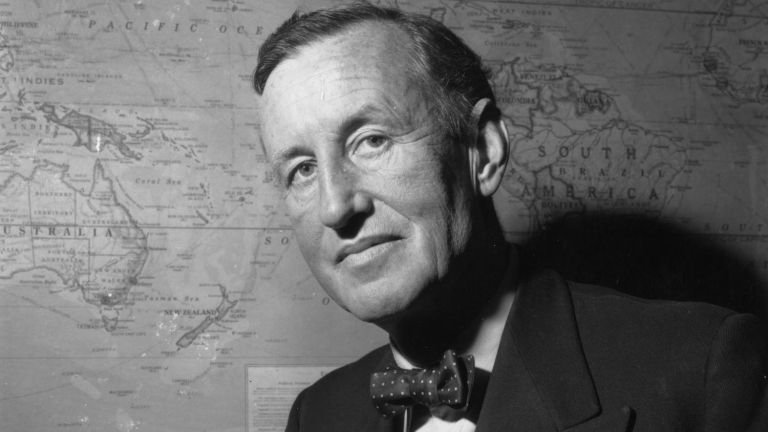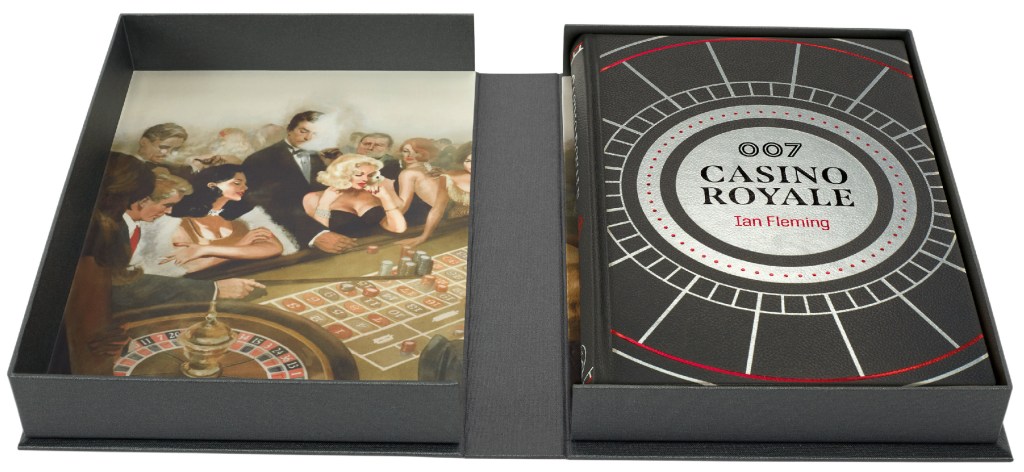Ian Fleming’s Original James Bond Looked Nothing Like the Start of a Sexy Movie Franchise
Seventy years after its publication, the literary Casino Royale features a James Bond we would hardly recognize today.

Happy birthday, Mr. Bond.
It was 70 years ago last week (April 13, 1953, to be exact) that author Ian Fleming published Casino Royale, the first novel to feature his soon-to-be-iconic British secret agent, James Bond. Fleming had worked as a journalist earlier in his life and served extensively in British intelligence during World War II, two aspects of his background that provided lots of context and material for Bond’s exploits. Fleming’s own habits of drinking, smoking, gambling, and womanizing provided much of the rest.
“When I wrote the first one in 1953, I wanted Bond to be an extremely dull, uninteresting man to whom things happened,” Fleming told The New Yorker in 1962, two years before his death. “I wanted him to be a blunt instrument.”
The Bond of Fleming’s first novel is in some ways still very much the 007 of Fleming’s 11 subsequent novels (and assorted short stories), as well as the 25 official movies in the canon (and one outlier), but it’s also remarkable to think that this tough, pulpy, yet inarguably gripping novel was ground zero for a pop culture franchise and phenomenon that has come in many ways to represent—and be associated with—glamour, privilege, wealth, exoticism, and global jet-setting.
Fleming made a card game the centerpiece of his book
In the unusually faithful 2006 film version of Casino Royale, which marked Daniel Craig’s debut in the role and returned the cinematic 007 to a more grounded approach, you’ll remember that the central set-piece of the movie is not a car chase or a shootout, but a high-stakes game of poker (it’s baccarat in the novel) between Bond and the villain, Le Chiffre, with lots of illicit money at stake.
Along the way (in both the book and the movie), there are attempts on Bond’s life during and after the game, as well as scenes featuring torture, executions, and suicide. The world that 007 inhabits may have the veneer of high living—custom martinis, fine foods, expensive cars, tailored clothing, beautiful women—but underneath the surface it’s inhabited by ugly, dark, soulless people who are after power, money, and geopolitical domination, and will use whatever means at their disposal to obtain those.
Here are the opening lines of the book Casino Royale: “The scent and smoke and sweat of a casino are nauseating at three in the morning. Then the soul erosion produced by high gambling – a compost of greed and fear and nervous tension – becomes unbearable and the senses awake and revolt from it.” Boy, makes you just want to put on your tux and head over there, doesn’t it?
Fleming, who reportedly downplayed his own abilities as a writer, pens the novel in a hard, no-frills fashion, ending each chapter on a cliffhanger of some kind to keep the reader turning the pages. That and his incredible fascination with even the minute details of Bond’s life and the world in which he moves are perhaps the author’s most distinctive trademarks. He may not have considered his work literature, but Fleming knew how to tell a tale in a gritty, uncluttered fashion.
In this first novel, his 007 is a reflection of that. Bond is a cold and, in many ways, simple man, dedicated to his appetites and his mission, and perhaps at his best when they are intertwined. But the complex moral quandary at the heart of Casino Royale—how far is each side willing to go—begins to get to him, and he ponders resigning from the Secret Service even as he also starts to fall in love with Vesper Lynd, a section assistant who accompanies him to the casino as part of his cover.
When Vesper commits suicide and Bond discovers that she was blackmailed into working as a double agent by SMERSH (Soviet intelligence), something in his heart seems to close again. He forgets about resignation and relays the news of Lynd’s passing by saying, “The bitch is dead now.”
The modern Bond franchise has emphasized the glitter
Casino Royale was a bestseller in the UK when it came out, although it did not sell well in the U.S. at first. It wasn’t until President John F. Kennedy named Fleming’s fifth Bond novel, From Russia with Love, as one of his favorite books that the 007 series took off in America, paving the way for the arrival of the film series in 1962 with Dr. No.
Perhaps because film is a visual medium, the coldness and darkness of the literary Bond’s world was de-emphasized in the movies, starting with Dr. No and continuing for the next 60 years, right up until Craig delivered his final performance as the sixth Bond in 2021’s No Time to Die.
All the trappings of Bond’s life—the cars, the clothes, the booze, and especially the often-stunning locales—were pushed to the forefront in the movies, which also became far more fantastical throughout the years than Fleming’s books ever were (the movies also became increasingly less faithful to the text). Although Fleming himself named specific brands in the books, like Gordon’s gin or Bentley automobiles, the merchandising was taken to an extreme in the movies.
According to the Guardian, brands as elite as (the now defunct) Pan Am airlines, Aston Martin, and Jaguar cars, Bollinger champagne, Rolex and Omega watches, Heineken beer, Tom Ford suits, and Belvedere vodka have competed for screen space in 007 movies with more down-to-earth sponsors like KFC, Camel cigarettes, 7-Up, and even Playboy making appearances.
The Bond movies have come to represent not only a certain gold standard of action franchise filmmaking and the spy genre, but have become a pop culture symbol of extravagant living, expensive tastes, unrestricted globe-trotting, and uninhibited sex. While all these elements were present in Fleming’s books, the novels were at their heart about a cold, lonely, secretive man whose profligate tastes mask a damaged soul haunted by the job he doe—a job that no one, not even his superiors, wants to admit needs doing.
Celebrating Bond’s seven decades
Seven decades after the publication of Casino Royale, it seems difficult to imagine a pop culture landscape without James Bond. Yet surprisingly, the celebration of 007’s 70 years on the planet seems muted for the moment. Perhaps the biggest way to commemorate the occasion would be Eon Productions’ announcement of whichever actor is going to become the seventh official version of James Bond. But despite a continual loop of rumors online and in the pages of British tabloids, it doesn’t seem like Eon is in any rush to unveil the next screen iteration of 007 just yet.
The Ian Fleming estate, meanwhile, has published brand new paperback editions of all 14 of the author’s Bond books—12 novels and two short story collections—to commemorate the 70th anniversary of Casino Royale, although the text of some of the books has been controversially altered to reflect modern sensibilities.
Fortunately, Casino Royale is not one of those books and remains untouched in a lavishly illustrated new edition of the original novel by British publisher Folio Society. In addition to their beautifully rendered editions of essential Marvel Comics collections, classic sci-fi, horror, and fantasy novels (including George R.R. Martin’s A Song of Ice and Fire), Folio Society has been publishing all of Fleming’s Bond books in equally lovely hardcover editions (we’ve bought a few and can heartily endorse them).
Folio’s 70th anniversary edition of Casino Royale is boxed, illustrated, leatherbound, and limited in number to 750 copies. It’s also expensive, we have to warn you (the other Folio Bond editions aren’t cheap either, although more moderate in price), but that somehow seems befitting of the character. Whatever edition you might wind up seeking out, it’s worth re-reading Casino Royale and rediscovering where it all started for James Bond, one of the enduring literary and cinematic creations in modern history.

